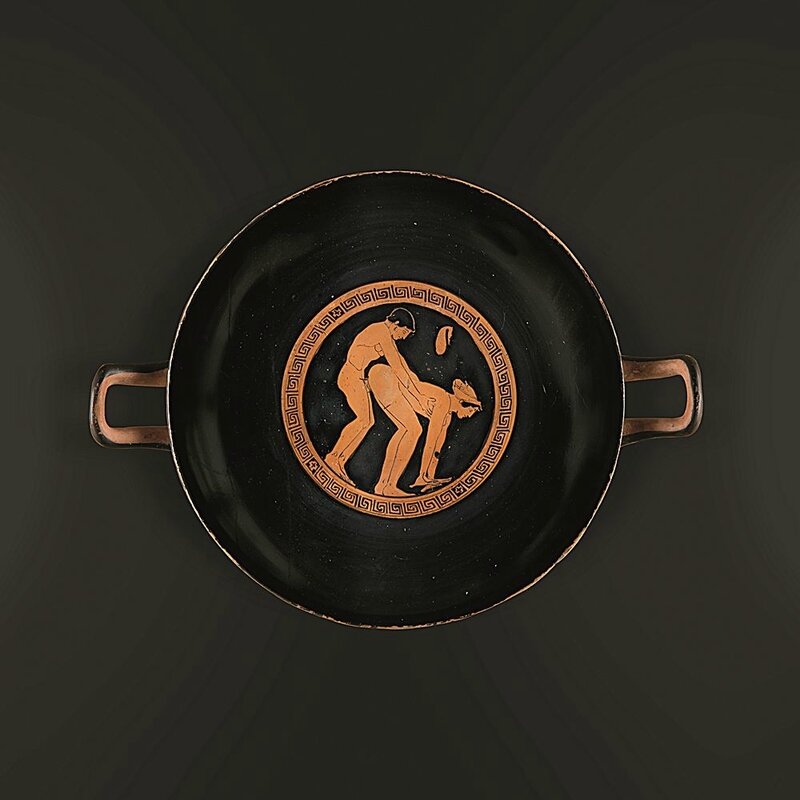J. Bagot Arqueología Ancient Art Gallery at BRAFA, 27 Jan - 4 Feb 2018, Stand 53a
Attributed to the Wedding Painter, active in Athens from circa 480 to 460 BC, Greek erotic kylix. Pottery. Greece, Attic, 5th century BC. Ø 29.5 cm. © J. Bagot Arqueología Ancient Art Gallery
Provenance: private collection, Barcelona; previously in a private collection in Munich from 1946; in the private collection of Mr. Julius Arndt (1865–1937), German archaeologist in classical antiquity
Literature: H. Licht (real name: Paul Brandt), ‘Sittengeschichte Griechenlands’, vol. III, Dresden and Zurich, 1928, p. 193.
Janus-form herm of Apollo and Dionysus as a child. Marble. Roman, 1st-2nd century AD. H 19 cm. © J. Bagot Arqueología Ancient Art Gallery
Originally the herm is a Greek pillar with a bust of the god Hermes on top, hence the name. It was placed to mark and demarcate roads as well as the limits of properties and also to protect against the evil influence of spirits, adversaries or enemies. In the Roman period it merely had an aesthetic function as evocation of classical Hellenism. On a Janus-form herm the two heads face in opposite directions and are only joined at the neck. The choice of these two gods is not fortuitous because in Greek mythology Dionysus embodies the savage power of nature, while Apollo is generally a divinity associated with ethics
Provenance: private collection, Vienna, acquired before 1970.
Statue of the Goddess Athena. Bronze. Lost-wax technique. Roman, 1st century AD. H 20.8 cm. © J. Bagot Arqueología Ancient Art Gallery
This is a powerful image of the goddess Athena, in comparison to other small ex-votos preserved. Her identity is determined by the Doric peplum she wears and the protective 'aegis' disc on her chest, with the mask of the Gorgon Medusa in the centre, a typical attribute of her image and a symbol of protection for the people and armies under her guardianship
The high quality of this work evokes that of the best pieces of small toreutics from the Romano-Oriental workshops where these statuettes were made
Provenance: private collection E. B., Barcelona, acquired from a private German collection
Literature: Christie's New York, Antiquities, 5-6 December 2001, lot 619.
J. Bagot Arqueología Ancient Art Gallery at BRAFA, 27 Jan - 4 Feb 2018, Stand 53a. Consell de Cent 278ES-08007 Barcelona. t +34 93 140 53 26 - m +34 617 19 80 62 - info@jbagot.com - www.jbagot.com

/https%3A%2F%2Fprofilepics.canalblog.com%2Fprofilepics%2F1%2F0%2F100183.jpg)
/https%3A%2F%2Fstorage.canalblog.com%2F03%2F02%2F119589%2F96711876_o.jpg)
/https%3A%2F%2Fstorage.canalblog.com%2F11%2F31%2F119589%2F94773502_o.jpg)
/https%3A%2F%2Fstorage.canalblog.com%2F20%2F83%2F119589%2F94772815_o.jpg)
/https%3A%2F%2Fstorage.canalblog.com%2F26%2F72%2F119589%2F75604929_o.jpg)
/https%3A%2F%2Fstorage.canalblog.com%2F59%2F60%2F119589%2F26458628_o.jpg)





/http%3A%2F%2Fstorage.canalblog.com%2F15%2F92%2F119589%2F117929349_o.jpg)
/http%3A%2F%2Fstorage.canalblog.com%2F71%2F87%2F119589%2F110418294_o.jpg)
/http%3A%2F%2Fstorage.canalblog.com%2F23%2F63%2F119589%2F35629056_o.jpg)
/image%2F1371349%2F20240411%2Fob_89f77b_telechargement-2.png)